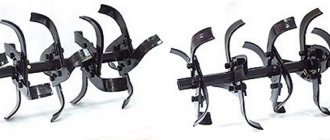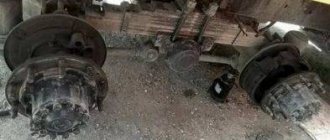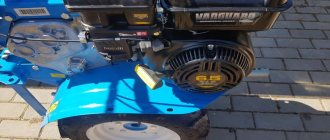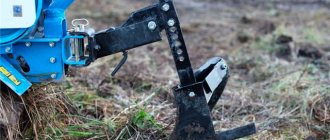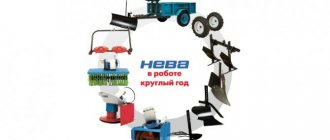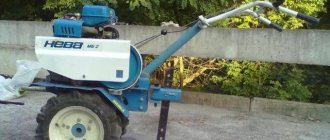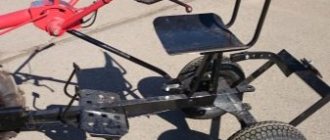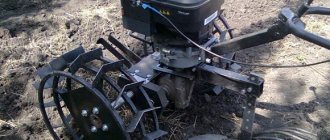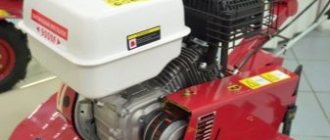Virtually all manufacturers of walk-behind tractors supply garden equipment with tillers in disassembled form. Their assembly is often difficult, especially if the number of cutting knives in each section is 4. Difficulties are associated with the large number of assembly parts and the need to correctly place them on the sleeve. Let's find out how to correctly and quickly assemble cutters on a walk-behind tractor with a different number of cutting blades. Assembly elements are mounted using washers, nuts and bolts.
Varieties
Several types and forms of this tillage tool are used. Let's look at all the types in more detail, because... Assembly differs depending on the type of cutter.
Saber-shaped
Saber-shaped or saber cutters are the most common, classic type. They are used on most walk-behind tractors. Their durability and practicality is evidenced by the fact that they are also used on powerful agricultural machinery for cultivating large fields.
The photo shows the classic version:
They have a number of advantages, such as replaceable blades. If desired, you can remove one blade, sharpen it, straighten it, or replace it with a new one. The fastening is carried out using bolts.
One blade is made as a monolith, a single piece, from a single strip of metal. There are no welded or riveted or screwed elements on it that could fall off due to significant loads when cultivating the soil.
The geometry of each blade and their location relative to each other are designed in the best way so that the cutting edges enter the ground easily and pass through it without unnecessary loads on the transmission and engine. At the same time, the soil is effectively loosened, lifted and mixed. At the same time, there are no gaps in the form of strips of uncultivated land. The entire processed strip is completely covered by the cutting edges of the left and right knives.
The cutters are made of special durable alloys that have undergone heat treatment (hardening). They are not fragile, they can withstand to some extent, bypassing, for example, a stone.
The quality of the alloy varies greatly among different manufacturers.
Crow's feet
This type of design appeared many years ago as a homemade one, made on one’s own for one’s own needs. Then it was noticed, and after some modifications this type of cutter began to be produced in the factory for walk-behind tractors.
The advantages of this option compared to the classic one:
- sharp tips penetrate the soil more easily, which is important when processing heavy, dense and dry, petrified soils. It is much easier for a walk-behind tractor to work with them;
- grass and roots can also wrap around them, but less than with saber ones. The posts here are straight, not bent. Some fibers slip between them.
The only downside to this option can be the poor quality of the factory execution of each specific product. Welded triangular cutters may fall off. If the unit is made as a non-separable unit, if one cutter is hopelessly broken, the entire unit will have to be replaced.
Due to the straight shape of the posts, such a cutter cuts the earth more than it lifts, loosens and mixes. Only triangular incisors work here.
Spiral
Structurally, this is a type of “crow’s feet”.
Difference from the usual version:
- semicircular shape of supporting posts;
- rectangular shape of the incisors.
The advantages and disadvantages are the same as those of the “crow’s feet” described above. There is a peculiarity - due to the small area of the incisors, there may be gaps; not the entire area is trimmed and loosened.
Functions
The milling cutter is the main working element that directly performs the work of cultivating the land. Therefore, so much depends on quality.
The sharp part makes a cut in the ground, making a revolution and rising up. The shovel picks up and lifts part of the earth. Thus, the earth is loosened, mixed and aerated (saturated with air), which all together is the main task in cultivating (cultivating) the land.
Along the way, the blade either cuts the roots of the weeds, or catches them and pulls them out. In any case, the growth of perennial root-propagating weeds is temporarily disrupted.
Elements of milling cutters for walk-behind tractors
A classic reciprocating cutter for a walk-behind tractor consists of three parts:
- supporting power shaft , rectangle or pipe, which transmits rotation from the gearbox and carries the remaining elements;
- flanges , which are tightly fixed to the shaft with holes for bolting replaceable cutting blades;
- knives, replaceable cutting blades.
All other types of cutters consist of the same parts. The difference is that “crow’s feet” and spiral cutters are most often non-separable, all elements are welded.
Advantages
Milling today is the most important agricultural technique.
Deep cultivation of the land is carried out in two ways - plowing and milling. The first method was the only one for thousands of years, since there were simply no cutters before.
The advantage of milling: high-quality and complete loosening of the soil, aeration and mixing of layers. The plow simply makes a half or full revolution of the formation. At the same time, soils with a dense structure may not crumble and remain in large clods. This requires additional processing with harrows, disc cultivators or small coulters, and in small areas with rakes.
An additional operation greatly increases labor and energy costs and reduces overall labor productivity. After cultivation with a milling cutter, no large lumps remain on most soils, and the soil is immediately completely ready for sowing.
Cultivator device
A standard cultivator consists of a frame on which the engine, transmission, working shaft with working tools, control handles, one or two transport wheels, and a protective visor are mounted.
The main working tool when working with cultivators are tillers. For most cultivator models, they are made as connections of two, four or six fairly easily removable sections. By selecting their number, they create the processing width required at this stage of work. The rotation of the cultivator cutters leads to cutting the soil into layers, crushing them and mixing them. In this case, the cultivator does not have drive wheels; it moves forward with the help of cutters, which also move, “push” it forward and cause movement.
In addition to the standard tillers described above, cultivators can, if desired, be equipped with a variety of attachments, which significantly expand the possibilities of performing agricultural work on them. Of course, such an additional “attachment” is purchased separately by the owners of the cultivators, so when choosing a cultivator for purchase, it will be useful to compare not only their technical parameters, but also the range of their equipment, their compatibility with various attachment options.
How to assemble cutters on a walk-behind tractor step by step
Assembling a cutter for a walk-behind tractor takes 1-2 hours, but it can take a long time and become a problem if suddenly a complete set of fasteners is not available.
These are the kits used to assemble the cutters:
Despite its apparent simplicity, this is a rather complex assembly in which the correct placement of the blades is extremely important. On different assemblies there can be from 6 (two cutters with 3 blades each) to 32 (8 cutters with 4 blades each).
The video will show how to assemble cutters for a walk-behind tractor:
All blades are divided into left and right. For some, the sharpened cutting edge is bent in one direction, for others - in the other. Sometimes there are assemblies with 3 left and 1 right blades, or other combinations. There are assemblies with 1 shortened blade.
If assembled incorrectly, the following problems arise:
- The walk-behind tractor jumps during operation and moves jerkily (one or more blades are turned with the blunt side towards the ground);
- one strip is processed by two blades, but an unplowed strip remains nearby (all blades are turned in one direction);
- if all the blades are installed with the cutting edge sharpened in the opposite direction, the walk-behind tractor will not be able to plow at all;
- An incorrectly installed blade can hit the gearbox. At low speeds the engine will simply stall; at high speeds the gearbox can be punctured and the blade bent.
After any assembly and installation on the walk-behind tractor, it is necessary to rotate the cutters without starting the engine and check that the blades do not cling to the parts of the walk-behind tractor.
Assembling new blades can be done without problems if you have an old factory cutter in front of your eyes. In this case, new blades are installed looking at the correct sample.
If the installation of new blades is carried out on the old shaft and flanges, before removing the old blades, you can photograph their position on a smartphone or sketch it. You can simply remember if you disassemble one cutter after another sequentially, and not remove all the blades at once.
Figuring out from the manual how the blades should be positioned can be a challenge. The picture does not always show the correct position. Translation from Chinese may not be clear. Numerous videos on this topic on the Internet may not help, since (see above) the assemblies are all different. Sometimes the video shows simply incorrect assemblies. The correct information will have to be collected piecemeal.
If the old cutters were disassembled a long time ago, not everything is clear in the manual, there is no clear video with a suitable model, assembly is carried out according to the following general rules:
- the outer blades are always attached inside the flange area (from the side of the walk-behind tractor), and not outside;
- on most models there are equal numbers of left and right blades. On a 4-blade assembly - 2 left and 2 right;
- left/right blades alternate, turned in different directions. But be sure to keep the cutting edge facing the ground.
Let us remind you that there are models and kits with other combinations.
But no matter what blades and in what combination were on the walk-behind tractor, you can purchase a standard kit (example in the photo above) and assemble it. In this case, the main thing is that it matches the walk-behind tractor model in size, shaft diameter, etc.
Maximum width and depth of cultivation
Tilling width is the maximum strip width that the cultivator can cover. A very narrow coverage adds time that is required for high-quality soil cultivation. The width of the processed strip depends on the engine power. Approximately 1 hp required for twenty centimeters of land covered in width. A wide grip is more convenient for processing large areas of land. If weeding between beds is important, then a narrow grip is more convenient.
The tillage depth reflects the distance to which the cultivator cutters penetrate the soil. As a rule, it is directly proportional to the diameter of the cutters. In some cases, the manufacturer separately indicates the cutting depth and cutter diameter. The average value usually does not exceed 25 cm. The tillage depth is set by the adjustable position of the coulter (a strong metal strip that is vertically fixed to the rear of the cultivator). The cutting width is usually adjusted by installing various cutters.
Cultivator with a maximum cultivation width of 1050 mm ZIGZAG GT 903
Cultivator with a maximum cultivation depth of 350 mm Workmaster WT-85
Installation
To install the cutters, it is enough to perform a number of simple operations:
- Tilt the walk-behind tractor on its side.
- Remove the wheel and install a cutter in its place. Pay attention to the rotation, the cutter must be installed with the blade forward so that it cuts the ground.
- After installation, secure the cutter on the gearbox shaft with a special cotter pin.
- Tilt the walk-behind tractor on the other side and do the same.
Installation is carried out the same way for all types of cutters and on all walk-behind tractors. It is recommended that two people perform this operation: one holds the cultivator, the other puts on the cutter.
Number of speeds
The number of forward speeds allows you to adjust the speed of the cutter and determine the type of work with the soil as described above. On modern cultivators, it is desirable to have a reverse gear. Light and ultra-light models, of course, do not have reverse gear, but they have a special handle to make it convenient to lift the cultivator and turn it in the right direction. This will be especially useful when working near various obstacles (fences, for example) or in some narrow, limited areas when you constantly need to make an effort to rearrange the cultivator. Heavy class devices weighing more than 60 kg have reverse as standard.
Reverse cultivator FERMER FM-701MS
Do I need to sharpen cutters?
The cutting edges of the blades must maintain the same sharpening angle (sharpness) as in the new (factory) state. If you sharpen the cutters more strongly, they will very quickly become dull to their previous state, since the soil is a strong abrasive, especially sandy.
Extremely dull edges will make work much more difficult. There will be extra load on the gearbox, engine and entire transmission, causing accelerated wear. Work will proceed more slowly, with excessive fuel consumption. Dense soils may not be able to be processed at all.
The cutting edges of the blades of walk-behind milling cutters should be sharpened to factory condition as they become very dull. The blade should cut, not crush the ground.
Too frequent and sharp sharpening will lead to the following problems:
- loss of time for sharpening, consumption of grinding wheels;
- abrasion of the blades during sharpening, which will accelerate their wear.
In addition, the edge, sharp as a knife, cuts the roots of weeds, which are then pulled away throughout the area. Thus, root-propagating weeds spread throughout the entire area. These include dangerous weeds such as wheatgrass, which can clog the entire area. It is difficult to weed them out, as they sprout again from the roots. A blunter cutter pulls the roots out of the ground. They are wound around the blades and shaft, then removed outside the site.
Blades made of high-quality and properly selected metals and alloys do not dull for long enough. If the edge rounds critically quickly, it means the metal is soft and the blades need to be replaced with high-quality ones.
When you need to sharpen cutters for a walk-behind tractor:
In addition to the cutters described above, there are unique designs for walk-behind tractors on sale. For example, a cutter made in the USA for the Mantis walk-behind tractor.
Many homemade cutters are also created - from springs, header tips from a combine, etc. There may be unsuccessful homemade options, but sometimes they are more effective and reliable than factory ones.
As can be seen from the article, most cutters are monolithic and only the classic version requires assembly. There is nothing complicated about this, just screw the knives to the base according to the diagram, observing a certain order.
engine's type
Engines can be gasoline, diesel, electric. Gasoline engines, in turn, can be two-stroke or four-stroke. Electric motors can be powered either from the mains, that is, they must be constantly connected to an outlet using an electrical cable of the required length, or from a built-in battery.
Electric engines and two-stroke gasoline engines are usually used in light class cultivators. Four-stroke gasoline and diesel engines are installed on medium and heavy class cultivators. The difficulty of operating cultivators with a gasoline engine is the need for constant maintenance. Fuel should be added regularly and oil should be used to lubricate parts. In addition, each model requires certain brands of oil and fuel, so you must strictly follow the instructions. Compared to electric models, gasoline models make too much noise. It is worth remembering about gasoline exhausts, harmful plants, soil and people. Models with a two-stroke engine are cheaper and simpler, but they require more fuel.
Electric cultivators do not have as much power as models with an internal combustion engine, but are great for small areas. Also, according to the observations of some users of electric models, vibration can irritate bees if work is done near the apiary.
Petrol cultivator Crosser CR-K12
Diesel cultivator ZIGZAG DT 902
Electric cultivator FERMER F-105
